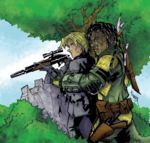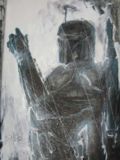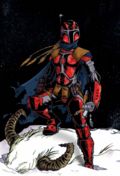Mandalorian culture was a self-perpetuating social construct revolving around family, warfare and survival. It was unique in its disregard for actual blood relation and species; and emphasis on independence. Its defining principals were codified into a central mandate known as the Resol'nare or the Six Acts.
- wearing armor,
- speaking Mando'a,
- defending themselves and families,
- raising children as Mandalorians,
- helping the clan succeed and sustain itself,
- when called to arms by the Mandalore, rally to his cause.
Mandalorian culture exibited a latent, almost xenophobic mistrust and contempt for outsiders that ran so deep that the word for "outsider" (aruetii) shared the same root as the word for traitor and enemy - despite their practice of inducting select outsiders into their family units via adoption.
Mandalorian social structure was a nomadic, clan centered semi-anarchy that acknowledged only one populist authority figure, called a Mand'alor in addition to individual clan elders. Mand'alors were made, not born in the sense that Mandalorians had no dynastic order of descent. To say that Mandalorians could not be led, only convinced to choose to follow is the most accurate assessment of Mandalorian governance.
The only leader of the Mandalorians was the Mandalore himself, and he held his rank as long as he commanded the respect of his fellow warriors. In battle, Mandalorians would be assigned to different squads and jobs, depending on their area of expertise. The Mandalorians worked together to the best of their ability in battle. Mandalorians were not promoted to better jobs, since they did not have jobs — only in battle would some kind of organization need to occur.
Individual Mandalorians were independent warriors, bound together by the same culture. Each piece of Mandalorian steel was created, chosen and customized by a Mandalorian to their level of skill. The armor had great cultural significance for the Mandalorians, and each set told about the Mandalorian underneath. However, there was a saying in Mando'a: "Verd ori'shya beskar'gam", meaning a warrior is more than his armor.
Sometimes the color of a Mandalorian's armor had a specific meaning. Black, for example, signified justice, while gold armor was for vengeance. Green armor signified duty. Blue was for reliability, gray for mourning a lost love, and red was to honor a father. Or the color of a Mandalorian's armor could signify nothing more than that they liked the look.
The Mandalorians were nomadic warriors despite the fact that they had the home world of Mandalore. The Mandalorians kept their nomadic ways so that in the event of attack, there would be no easy way to exterminate the Mandalorians. They also built no straight roads on Mandalore in order to make it much easier to ambush and pin down any invaders. Tactics such as these contributed to the Mandalorians' survival over thousands of years. This also meant that many Mandalorians had never visited Mandalore.
Not all Mandalorians constantly fought on the front line. There were farmers, regular factory workers, engineers, and doctors too. However, all Mandalorians were warriors at heart, and all knew how to fight.
Practical, no nonsense and straightforward, Mandalorians had very little use for ostentatious ceremony and red tape. Unlike many civilizations, they lacked a strong central government and the mass of invasive laws that went along with it. Marriage contracts, agreements and deals were forged verbally, with a typically Mandalorian lack of pomp and circumstance; and rarely recorded. Only with outsiders did Mandalorians feel a need to exercise more cumbersome, bureaucratic methods of agreement making.
Despite their rather gruff appearance and style of combat, the average Mandalorian was more sociable and kind than one would expect. As long as individuals spoke their mind, accepted a meal when offered, looked them straight in the eye (or the horizontal section of their visor), took off their boots when guests, paid their debts, fussed over their children, never made a pass at a Mandalorian of the opposite sex (unless the individual planned to become part of the culture) and respected the elderly, anyone who encountered a Mandalorian was not likely to be killed.
|
 A father teaching his son Gender roles were more or less identical in Mandalorian society. Males and females were expected to perform the same tasks with the same degree of proficiency regardless of sex. This complete lack of gender bias is reflected in their language's lack of distinction between male and female pronouns. The lack of gender differentiation socially seemed to also apply to interpersonal relationships in that the Mandalorians attached no stigma to same-sex pairings.
Family was very important to the Mandalorians, yet when compared to most other cultures, they held very different beliefs as to what constituted a familial relationship. Despite the fact that fidelity and chastity before marriage was highly emphasized, they were unconcerned about parentage. Believing that aliit iru'shya tal'din (Family is More Than Bloodlines), it was common for orphaned children, and even adults, to be brought into the culture.
Adoption was commonly practiced among the Mandalorians. Known as gai bal manda (name and soul), it was a regular occurance for Mandalorians to adopt not only children but adults who sufficiently impressed them. For the Mandalorians, there was no difference between a "real" child and an adopted one. This was not a lightly regarded thing, as Mandalorians took the health, welfare and succsess of their families extremely seriously.
Mandalorian women were expected to have the same combat skills as men, in order to defend their homes when the men were away. If they didn't have children to raise, they fought alongside men on the battlefield. The ideal Mandalorian woman was physically strong and resilient.
Mandalorian children were an integral part of the culture for their importance in the continued survival of the clan unit and the Mandalorian people as a whole. Contrary to the grim, pitiless reputation Mandalorians had with the rest of the galaxy, they were loving, committed parents who made a great deal of fuss over their children. It should be noted that however doting Mandalorian parents could be, they did not coddle their offspring and were known to train them to use weapons and armor from a very early age and to send them along with a parent to learn actual warfare before they were ten years old. Mandalorians were considered adults at the age of thirteen, when they would undergo a trial (the verd'goten, or coming of age) turning them into warriors.
This contributed to the fact that Mandalorians married and settled down earlier than most cultures. Family bonds were a large part of the Mandalorian culture, and as a result, they felt more comfortable around each other than they did around strangers.
The elderly were equally revered among the Mandalorians. It was commonly espoused thinking that a warrior didn't survive to reach a venerable age unless they remained strong, intelligent and skilled. As with children, there was no coddling or humoring of the elderly, but respect was granted based on an oldster's individual merit and experience. It is to be noted that very few Mandalorians are known to have died of natural causes related to old age.
|





